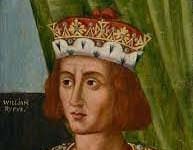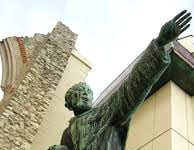“Discover the life and work of Omar Khayyam, the renowned Persian polymath known for his contributions to mathematics, astronomy, and poetry. From his groundbreaking work in algebra and calendar reform to his timeless *Rubaiyat* quatrains, explore the legacy of this influential philosopher and poet whose reflections on life, fate, and the human condition continue to resonate across the world.”
Omar Khayyam-Brief Biography
Omar Khayyam was a Persian mathematician, astronomer, philosopher, and poet who lived in the 11th and 12th centuries. He was born in Nishapur, Iran, in 1048 and lived until 1131.
Khayyam was a brilliant mathematician and astronomer, and he made significant contributions to the fields of algebra and geometry. He is best known for his work on the classification and solution of cubic equations, which helped lay the foundation for the development of algebra. He also wrote a treatise on the principles of algebra, which was widely used for centuries.
In addition to his mathematical and astronomical work, Khayyam was also a philosopher and poet. He was a Sufi, a member of a mystical movement within Islam, and his poems often reflected his philosophical and spiritual beliefs. He wrote about the transitory nature of life, the inevitability of death, and the search for meaning in a world that can often seem cruel and unjust.
One of Omar Khayyam‘s most famous works is the collection of poems known as the “Rubaiyat,” which was translated into English by the 19th-century British scholar Edward FitzGerald. The “Rubaiyat” has been widely regarded as a masterpiece of Persian poetry, and it has been translated into many languages.
Despite his many contributions to science, philosophy, and literature, Khayyam remained largely unknown in the West until the 19th century, when his works were translated and widely read. Today, he is remembered as one of the great thinkers of the medieval world, and his work continues to influence modern mathematical, astronomical, and philosophical thought. 0 0 0
Omar Khayyam-Facts
Early Life and Background
- Full Name: Ghiyath al-Din Abu’l-Fath Umar ibn Ibrahim al-Nisaburi al-Khayyami
- Date of Birth: May 18, 1048
- Place of Birth: Nishapur, in the province of Khorasan, Persia (modern-day Iran)
- Family Background: Omar Khayyam was born into a family of modest means. His father, Ibrahim, was likely a tentmaker (the term “Khayyam” means tentmaker in Persian), which might have inspired Omar’s surname. Despite his humble origins, Khayyam received an excellent education due to his early display of intellectual talent.
Education and Early Career
Education: Khayyam studied in Nishapur, focusing on philosophy, mathematics, astronomy, and Islamic theology. He was mentored by some of the most prominent scholars of his time and became known for his exceptional intellect and mastery of various scientific disciplines.
Influences: His early education was influenced by prominent scholars such as Bahmanyar, a student of the famous Persian philosopher Avicenna (Ibn Sina). Khayyam’s work reflects the rich intellectual traditions of his time, blending philosophy, mathematics, and mysticism.
Achievements in Mathematics and Astronomy
Mathematics: Khayyam made significant contributions to algebra, particularly in solving cubic equations. His work “Treatise on Demonstration of Problems of Algebra” (1070) presented a geometric method for solving cubic equations by intersecting a parabola with a circle.
He also contributed to the understanding of the binomial theorem and laid the groundwork for the development of modern calculus.
Astronomy: In 1074, Khayyam was invited by the Seljuk Sultan Malik-Shah to head an observatory in Isfahan, where he led a team of astronomers to reform the Persian calendar. The result was the ‘Jalali calendar’, which was more accurate than the Gregorian calendar used in the West.
This calendar reform demonstrated Khayyam’s advanced understanding of astronomical calculations and his ability to apply mathematical theory to practical problems.
Philosophical and Literary Contributions
Philosophy: Khayyam was well-versed in Islamic philosophy, particularly in the works of Avicenna. His philosophical writings explore existential themes, questioning the nature of reality, fate, and the human condition. He often expressed skepticism about the certainty of human knowledge and the constraints of religious orthodoxy, reflecting his complex and sometimes controversial views on religion and science.
Poetry: Khayyam is most famous today for his poetic works, particularly the “Rubaiyat,” a collection of quatrains (four-line poems). These poems, characterized by their lyrical beauty and philosophical depth, explore themes of love, life, fate, and the transient nature of existence.
The “Rubaiyat” was relatively unknown in the West until it was translated by Edward FitzGerald in 1859. FitzGerald’s loose translation popularized Khayyam’s poetry in Europe and America, often emphasizing its hedonistic and skeptical elements.
Controversial Views and Legacy
Religious Skepticism: Khayyam’s views on religion were complex and often considered unorthodox. While he adhered to Islamic practices publicly, his poetry reflects a more skeptical, even agnostic worldview, questioning the existence of an afterlife and the meaning of divine judgment.
This duality has led to varying interpretations of his work, with some viewing him as a devout Muslim philosopher and others as a freethinker or even a heretic.
Literary Legacy:
The “Rubaiyat” has been translated into numerous languages and continues to captivate readers worldwide. Its themes of existential reflection, carpe diem (seize the day), and the fleeting nature of life resonate across cultures and epochs. Khayyam’s influence extends beyond poetry; his contributions to mathematics and science were foundational, particularly in the development of algebra and calendar reform.
Later Life and Death
Return to Nishapur: After his work at the observatory in Isfahan, Khayyam returned to Nishapur, where he continued his scholarly pursuits in relative obscurity. He spent his final years teaching and writing, living a quiet life away from the political and religious controversies of his time.
Death: Omar Khayyam passed away on December 4, 1131, in Nishapur. His burial site has since become a place of pilgrimage, with a mausoleum built in his honor in the 20th century.
Posthumous Recognition
Western Rediscovery: Khayyam’s legacy was revived in the West primarily through Edward FitzGerald’s translation of the “Rubaiyat” in the 19th century. FitzGerald’s adaptation, though criticized for its inaccuracy, captured the spirit of Khayyam’s poetry and introduced him to a global audience.
The “Rubaiyat” became a literary phenomenon, influencing Western writers, artists, and thinkers with its themes of existential questioning and celebration of life.
Scientific and Philosophical Impact:
Khayyam’s work in mathematics and astronomy remains influential. His contributions to the theory of equations and the calendar reform demonstrate his unique ability to bridge abstract thought with practical application.
His philosophical musings, though less well-known, offer a rich tapestry of thought that blends skepticism with a deep appreciation for the mysteries of existence.
Conclusion
Omar Khayyam’s life and work embody the intellectual and cultural richness of the Islamic Golden Age. He excelled as a mathematician, astronomer, philosopher, and poet, leaving a lasting impact on both the scientific and literary worlds. His “Rubaiyat” continues to be celebrated for its timeless exploration of human nature, and his scientific achievements highlight his remarkable contributions to the advancement of knowledge.
Sources:
- “Omar Khayyam.” Encyclopædia Britannica. Encyclopædia Britannica, Inc., n.d.
- “Omar Khayyam.” Stanford Encyclopedia of Philosophy. N.p.
- “The Rubaiyat of Omar Khayyam.” Poets.org. Academy of American Poets, n.d.
N. B. This article originally belongs to the book, ‘Brief Biographies of Ancient Thinkers and Writers‘ by Menonim Menonimus.
Books of Biography by M. Menonimus:
- The World Writers-Brief Biographies
- Introduction to World Writers
- Introduction to World Personalities
- Love of Reputed Persons ..
Additional Searches:








